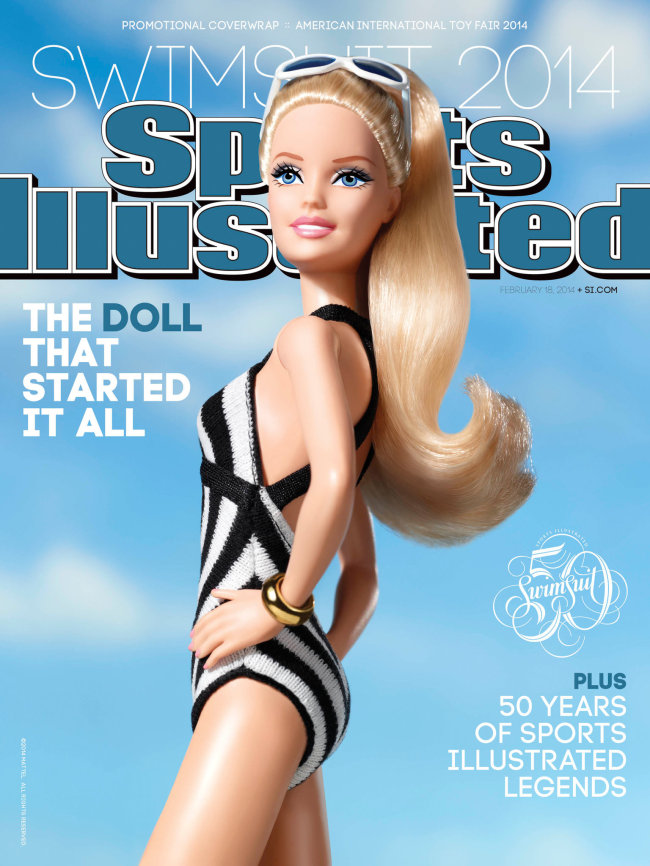 |
Sports Illustrated’s 2014 swimsuit issue. (AP) |
WASHINGTON (AFP) ― Barbie has been many things in her life: A doctor. A paleontologist. An astronaut. A cheerleader. A race car driver. A candidate for the presidency of the United States.
Now, on the threshold of her 55th birthday, the world’s most famous doll is stirring up a social media frenzy with her debut in Sports Illustrated’s 50th anniversary swimsuit edition.
In a tie-in with toymaker Mattel, the top-selling U.S. sports weekly has cast the leggy ― if anatomically impossible ― all-American doll on a mock cover, sporting a black and white one-piece reminiscent of the one she wore when introduced in 1959.
“The Doll that Started it All,” reads the headline on the cover, being wrapped around some issues of the magazine. The hashtag #unapologetic features in the joint marketing campaign, which will also include ads in the magazine.
“From its earliest days, Swimsuit has delivered a message of empowerment, strength and beauty,” said M.J. Day, the Sports Illustrated senior editor responsible for the iconic and highly lucrative special edition.
“And we are delighted that Barbie is celebrating those core values in such a unique manner,” she said in a statement.
The swimsuit issue comes out Tuesday with bikini-clad Chrissy Teigen, Nina Agdal and Lily Aldridge on the cover, posing on a sun-kissed tropical beach, smiling back at the camera, toned buttocks well exposed.
But it’s Barbie ― or more precisely the notion of giving her top billing in a magazine that pitches sun, sea and sex to impressionable American males in the dead of winter ― that has fired up the blogosphere.
“This is what is known as obvious trolling,” wrote Mary Elizabeth Williams at Salon.com.
“You plan on getting mad again this year about hot, barely clothed women in a sports magazine again this year, world? Here. Here’s a plastic one ... a freaking mass-produced doll.”
“Just as the swimsuit issue isn’t for the kids, Barbie isn’t for the grown-ups either,” added Eve Vawter, editor of Mommyish.com.
“Barbie is no longer just a doll. She is a sex doll. Think about that the next time your daughter wants one in the toy aisle.”
Barbie losing her mojo?
Alas, on the eve of the New York Toy Show, and hard on the heels of New York fashion week, Barbie is grappling with the middle-aged fear that she’s no longer hot stuff.
Publicly listed Mattel revealed in January that worldwide gross sales of its Barbie products fell 6 percent last year, and 3 percent in 2012, putting a drag on the profitability of the world’s biggest toy manufacturer.
“We just didn’t sell enough Barbie dolls,” said Mattel chief executive Bryan Stockton in a conference call with financial analysts, although its other doll lines such as Monster High are faring better.
Barbie ― whose brand is valued at $3 million, a tad more than Oprah Winfrey’s estimated worth ― is no stranger to controversy.
She’s regularly been faulted in the past for setting an unrealistic example for young girls with her impossibly lithe figure, fabulous wardrobe and storybook romance with dashing boyfriend Ken.
If 11.5-inch Barbie was a full-grown American woman, she’d have a 32-inch bust, a 16-inch waist and 29-inch hips, as well as a child’s size 3 foot, according to Rehabs.com, a website that addresses eating disorders.
Lindsey Feitz, who lectures on gender and women’s studies at the University of Denver in Colorado, considered it “ethically dubious” to use a girl‘s doll to sexualize girlhood in a magazine seen mainly by men.
“We’ve evolved from the ink drawings of pin-ups in the 1940s to chronic Photoshopping and digital body alterations of today‘s cover models,” Feitz told AFP by email.
“And now the model has disappeared and been replaced with a plastic representation of a sexy girl/woman. It’s ironic.”








